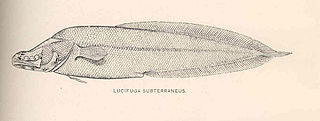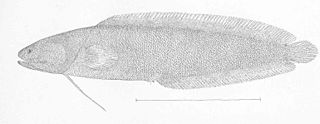Dinematichthys is a genus of viviparous brotulas. Its name comes from Greek, meaning two-filamented fish.

The viviparous brotulas form a family, the Bythitidae, of ophidiiform fishes. They are known as viviparous brotulas as they generally bear live young, although there are indications that some species do not. They are generally infrequently seen, somewhat tadpole-like in overall shape and mostly about 5–10 cm (2–4 in) in length, but some species grow far larger and may surpass 60 cm (2 ft).

Lucifuga is a genus of viviparous brotulas. Most of the species are native to caves and sinkholes in Cuba and the Bahamas; L. inopinata from deep water off the Galápagos Islands is the only exception. The four species rated by the IUCN are all considered vulnerable. The largest species in the genus reaches about 15 cm (5.9 in) in length.

Ogilbia is a genus of viviparous brotulas. The generic name honours the Australian naturalist James Douglas Ogilby (1853-1925), for his contribution to the knowledge of the fishes of Australia.
Alionematichthys is a genus of viviparous brotulas.
Beaglichthys is a genus of viviparous brotulas.
Dermatopsoides is a genus of viviparous brotulas.
Diancistrus is a genus of viviparous brotulas.
Didymothallus is a genus of viviparous brotulas found in the Indian and western Pacific Oceans.
Dipulus is a genus of viviparous brotulas.
Eusurculus is a species of viviparous brotula.
Gunterichthys is a genus of viviparous brotula.
Majungaichthys is a genus of viviparous brotulas native to the western Indian Ocean. The generic name refers to Majunga in Madagascar where the type was collected.
Mascarenichthys is a genus of viviparous brotulas. They have mostly been collected from the region of Mascarene Plateau in the Indian Ocean and this is referred to in their generic name.
Ogilbichthys is a genus of viviparous brotulas found in the central-western Atlantic Ocean and the Caribbean Sea. he generic name refers to the resemblance of these fish to those in the genus Ogilbia, a name honours the Australian naturalist James Douglas Ogilby (1853-1925), combined with ichthys which means "fish" in Greek.
Paradiancistrus is a genus of viviparous brotulas.
Tuamotuichthys is a genus of viviparous brotulas found in the Pacific Ocean.
Ungusurculus is a genus of viviparous brotulas found in the western Pacific Ocean.

Dinematichthyini is a tribe of viviparous brotulas, which is conventionally placed within the subfamily Brosmophycinae. They are differentiated from the other tribe within that subfamily, the Brosmophycinae, by having a single pair of ossified genital claspers, having an absence or greatly reduced scales on the head and having the posterior end of the maxillary bone showing a small amount of vertical expansion. A review of the viviparous brotulas carried out in 2016 elevated the tribe to a family, the Dinematichthyidae.
Didymothallus criniceps is a fish species described by Werner Schwarzhans and Møller in 2007. Didymothallus criniceps is part of the genus Didymothallus and the family Bythitidae. No subspecies are listed in the Catalog of Life.




